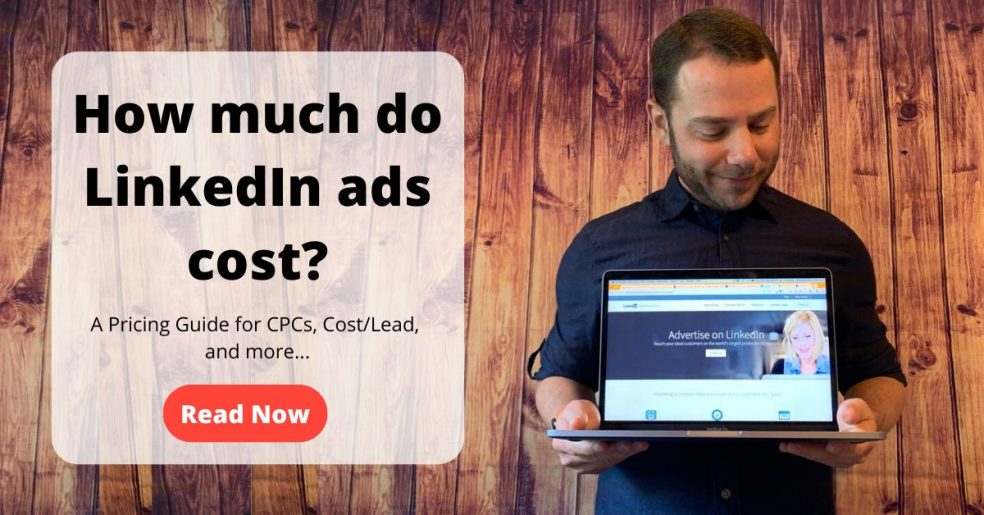Find out how much LinkedIn ads cost – including CPCs, Cost/Send, Cost/Lead, and more… and how to make the most of your investment.
LinkedIn is the most powerful B2B social network… and the most underutilized advertising platform.
You know LinkedIn as the world’s largest professional networking site. You’ve used it for years to connect with colleagues, find and post job openings, and learn more about your industry.
Now, you’re ready to leverage its advertising potential.
Though LinkedIn Ads have been around since 2005, it wasn’t until 2016 that they added key features, such as lead generation forms, video ads, carousel ads and more, that helped them ramp up their marketing presence.
Since then, LinkedIn Ads have grown in popularity and performance, allowing the social media platform to earn its place alongside Facebook Ads and Instagram Ads as a go-to way to get your brand in front of a wide audience.
Yet, before you begin a new LinkedIn Ad campaign, it’s important to understand the financial side. How much do LinkedIn ads cost and how can you plan your budget accordingly?
For the short answer, check out this cheat sheet here. For an in-depth analysis (and several ‘protips’) for what we see as an agency across all of our campaigns, read on…
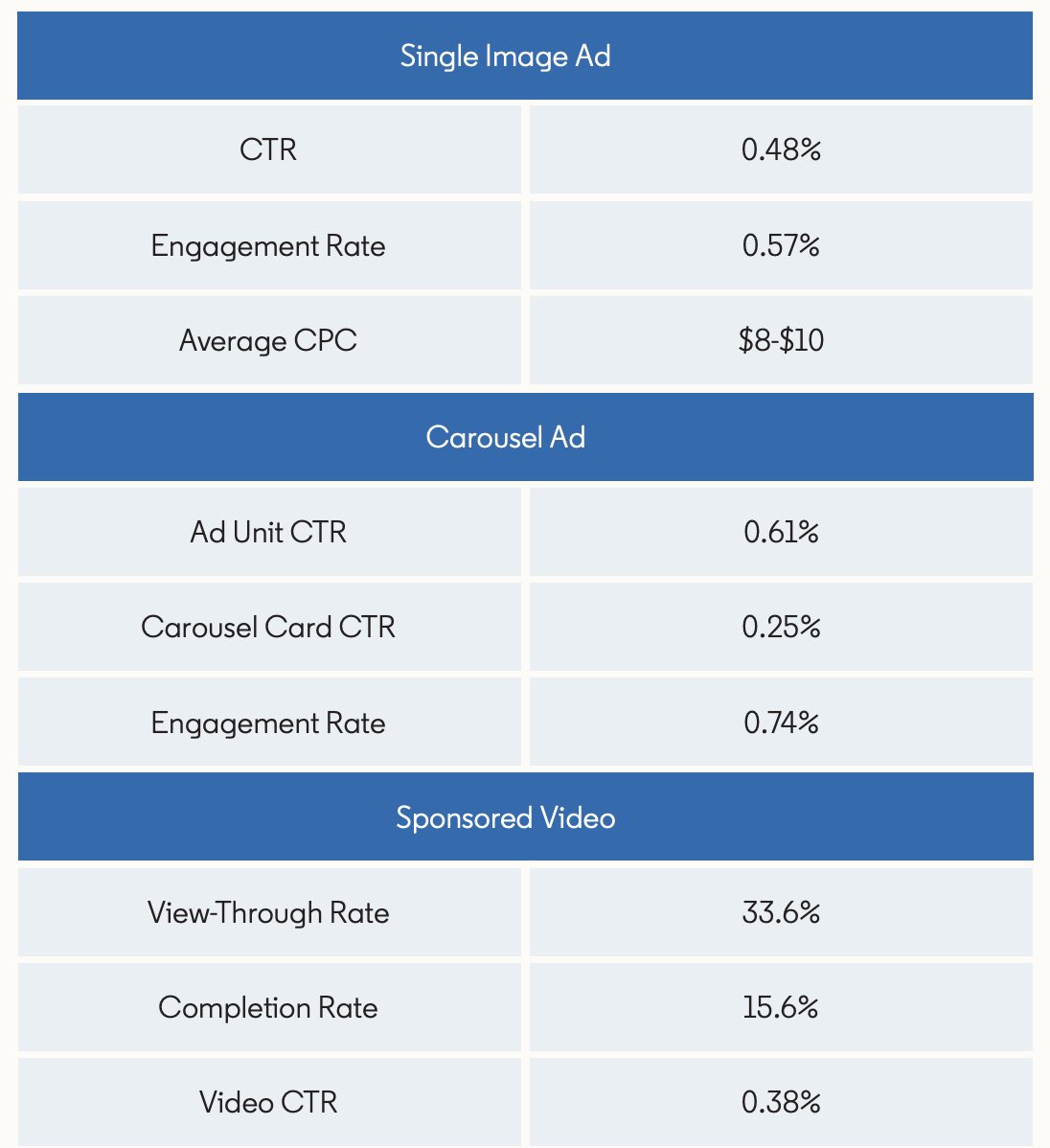
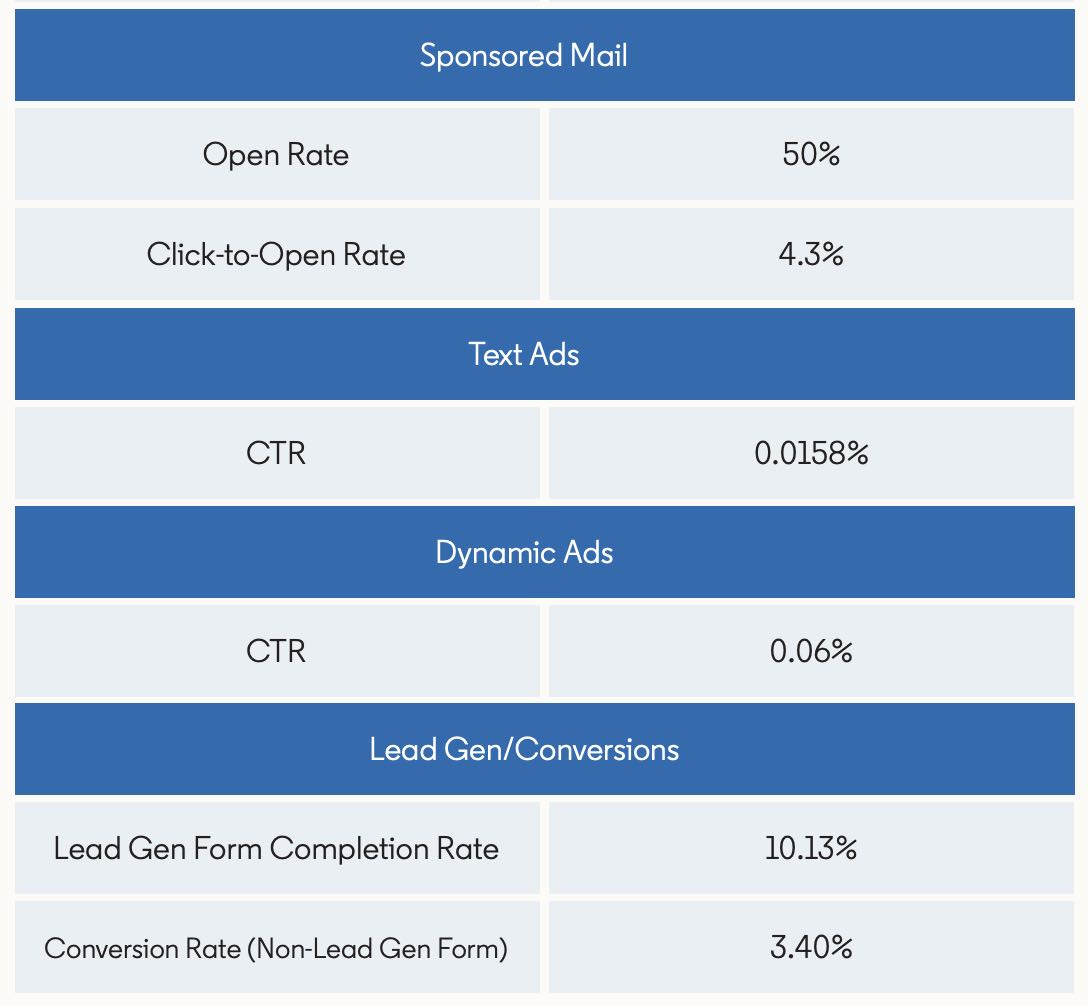
Source: Straight from LinkedIn Marketing Solutions, Themselves!
How Much Do LinkedIn Ads Cost?
Like some other forms of social media advertising, LinkedIn Ads are sold through an online auction. As such, there is no set cost for any kind of advertisement. Rather, it’s the marketers themselves who control how much they spend and whether or not their ads are visible, through supply and demand of eyeballs on the platform.
As a marketing manager, you can begin your ads whenever it’s convenient for your organization. You can also stop them at any time. You don’t need a sky-high marketing budget to get started, but you’ll want to budget enough to turn results.
That said, what do you need to have in place?
Let’s review the steps behind the LinkedIn Ad platform and how each affects your final cost.
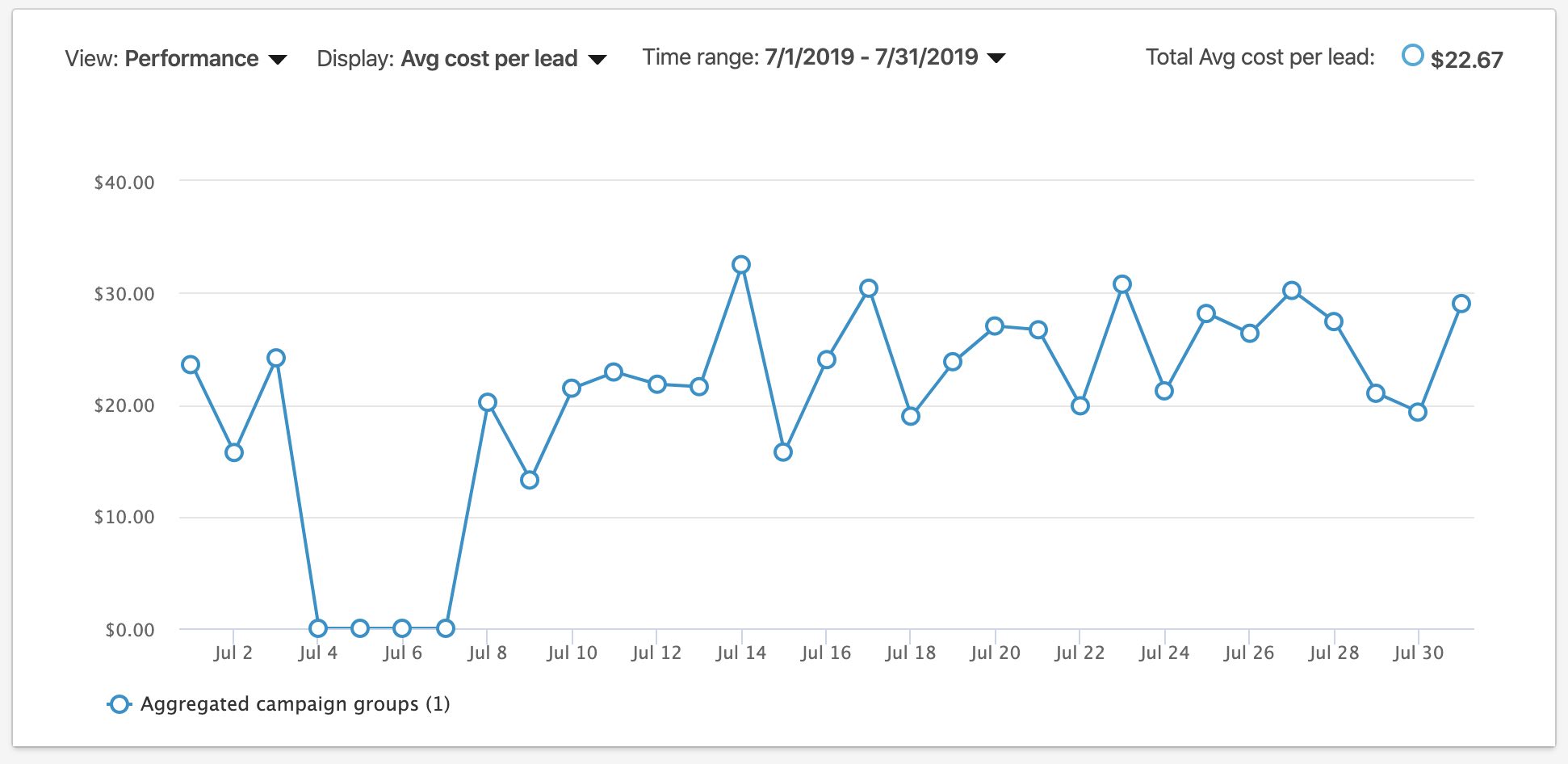
Just like any social media platform, performance and costs fluctuate day-to-day 📉
Step 1: Setting Your Target Audience
Today, generic advertising messages that appeal to a widespread audience have given way to ultra-targeted ads that cater to a specific buying demographic. This is especially the case with digital ads, which marketers can design to align with buyers’ tastes, preferences, and actions as much as possible.
Before you set up your LinkedIn Ad campaign, the platform will walk you through a few steps to make sure your content will reach the right viewers.
Targeting options for LinkedIn advertisements include filtering your audience by:
- Geographic location (required field)
- Company details (size, industry, name, corporate connections, number of followers)
- Personal demographics (age and gender)
- Education (field of study, schools where members completed at least one course, completed degrees)
- Job experience (function, title, seniority, skills, years of experience)
You can also use LinkedIn’s Matched Audiences tool to allow the platform to scan your website visitors, company lists, email lists and similar features to “match” your company with LinkedIn members.
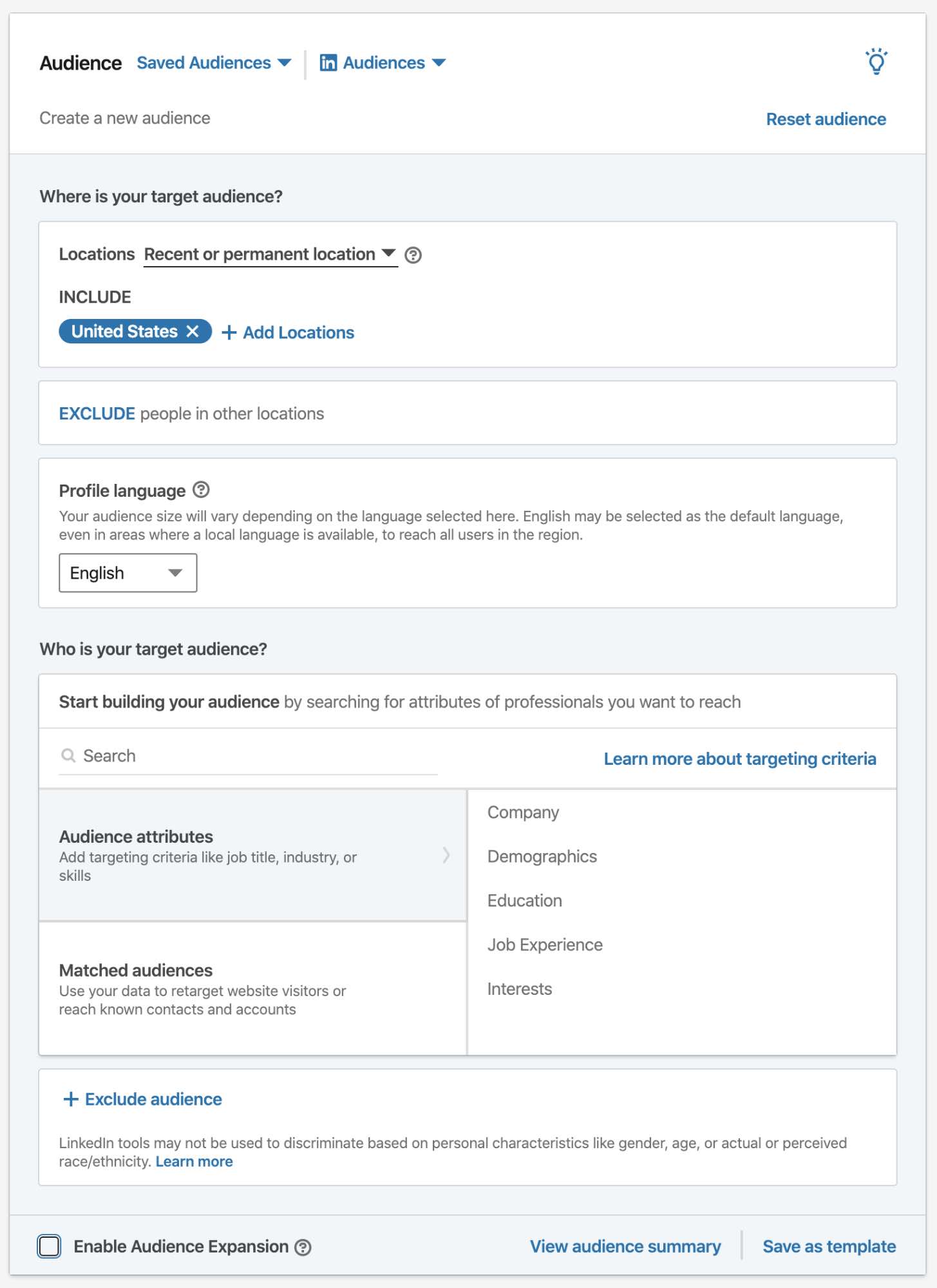
Different eyeballs cost different amounts 👀
Protip: I usually recommend unchecking ‘Enable Audience Expansion’. LinkedIn’s specific job and company targeting is why we use it. I would only recommend using this if your offer is widely appealing to professionals.
Recommended Audience Sizes
As you work through the myriad targeting options and make your selection, LinkedIn will adjust the audience size that you’ll be able to reach. For budgeting and projection purposes, keep in mind that your targeted audience will need to include at least 300 members.
However, that’s only a benchmark.
LinkedIn recommends certain audience sizes based on the kind of ads you invest in. Although there isn’t an exact number for every case and you’ll need to perform audience testing to make sure your efforts are on the right track, LinkedIn recommends setting the following audience sizes for each ad type:
- Sponsored content: At least 300,000 members (we find closer to 100,000 is the sweet spot)
- Text-based ads: Between 60,000 and 400,000 members
- Sponsored InMail: Ideally no more than 100,000 members
Though this step isn’t directly budget-related, it’s critical to understanding the scope of your campaign, which will affect your bottom line down the road. Next, let’s talk numbers.
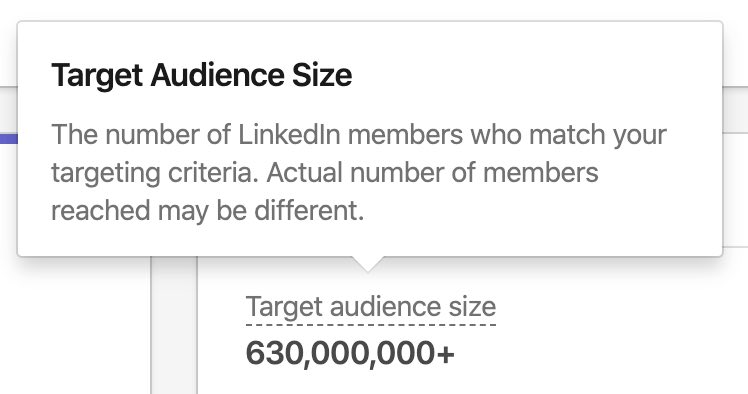
linkedin target audience size
Step 2: Choosing Your Ad Format
As mentioned above, LinkedIn offers marketers three different ways to promote their material. Let’s review each one to understand what the strategy includes.
Sponsored Content
Sponsored ads are advertisements that appear in the target viewer’s newsfeed, and come from your LinkedIn Company Page. You can promote your existing post from your Company Page as an ad or you can create a new ad (not visible organically on your Company Page). Sponsored content ads are viewable on desktop, mobile and tablet devices.
The different types of sponsored content include:
- Single-image ads
- Video ads
- Carousel ads

Oddly, you have to choose ad type at the campaign level. 🤷♂️
Pricing options for sponsored content include:
- Cost-Per-Click (CPC): This means you’ll only pay when people click on the ad.
- Cost-Per-1,000-Impressions (CPM): This means you’ll pay as people view your ads, not necessarily click on them.
Protip: LinkedIn Click-through rate is generally low, so we recommend starting as CPC for sponsored content ads. If your CTR is consistently above 1%, then it’s cheaper to switch to a CPM basis.
Text-Based Ads
Text ads are simple, non-graphic ads that appear on members’ news feeds. Only available on desktop versions, they’re displayed under headers including “Ads You May Be Interested In” and can also show up as text link advertisements on the LinkedIn homepage.
Pricing options for text-based ads include:
- Cost-Per-Click: This means you’ll only pay when people click on the ad
- Cost-Per-1,000-Impressions: This means you’ll pay as people view your ads, not necessarily click on them
Protip: LinkedIn Text ads are some of the cheapest clicks you can get on the social media platform. We often recommend them!
Need help with your LinkedIn Ads?
Drop me an email at anthony@speedworksocial.comSponsored InMail
Want to reach your members right in their LinkedIn inbox? Sponsored InMail advertisements show up there when they’re online. This allows you to send targeted messages to your audience, meeting them right where they are.
Pricing options for Sponsored InMail include:
- Cost-Per-Send (CPS): This means you’ll pay for each InMail message that LinkedIn successfully delivers
Protip: Sponsored InMail are some of the most expensive ad units on LinkedIn… so leverage it only for a targeted and appealing campaign (ie. Hiring & Recruiting Ads)
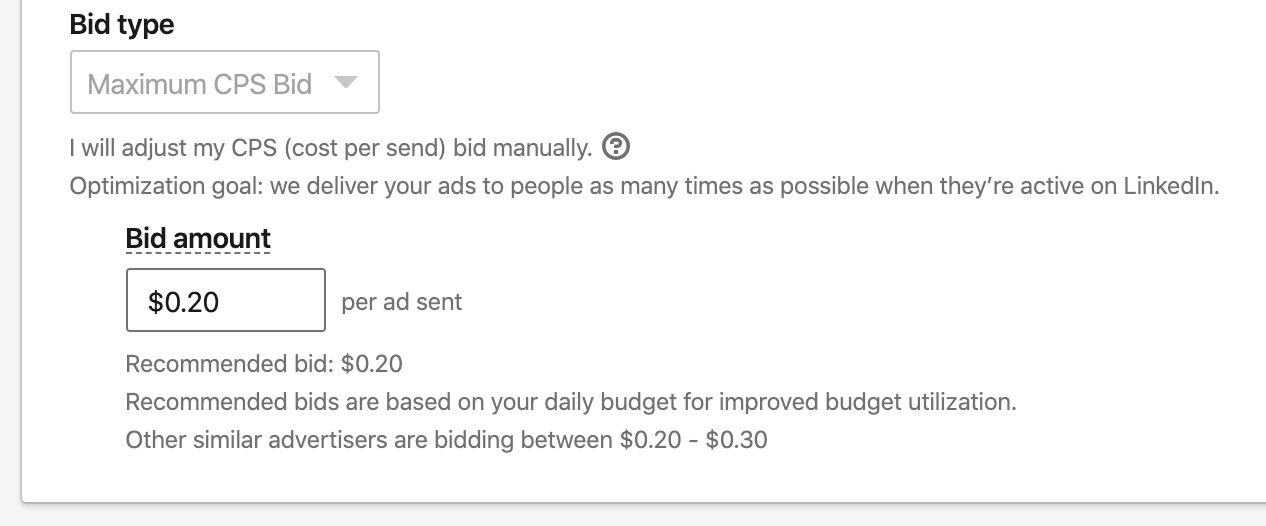
Step 3: Controlling Your Advertising Spend
LinkedIn allows you a few different ways to control your advertising spend. You can take charge of your investment in one of three ways, including:
- Setting a daily budget
- Setting a total budget
- Setting maximum bids
- Setting a Daily Budget
In this case, your daily budget is the maximum amount that your company wants to spend per day. The minimum is $10 USD and the maximum is $100,000.
Of course, it is possible to set a higher maximum daily budget but to do so, you’ll have to have special account privileges. This option is reserved for enterprise-account advertisers managed by a LinkedIn Clients Solutions Manager.
Setting a Total Budget
With this feature, you’ll give LinkedIn one dollar amount to work with: the maximum amount set aside for your campaign. Then, you’ll tell the platform to spend it all to get your numbers up, without following a dedicated schedule. These work best for time-sensitive campaigns that are more interested in short-term traffic, such as special promotions, event registrations, or giveaways.
Like daily budgets, the minimum budget for a total is $10 USD.
Note that if you started your LinkedIn Ads campaign before March 27, 2019, you had the option of setting a total budget as a standalone feature. The same applies if you duplicate a campaign launched before this date. These are labeled “Legacy” in Campaign Manager.
Keep in mind that now, total budgets are only available for campaigns that are set up to run as Dynamic Ad formats. If you’re running any of the below types of ads, you’ll be required to set a pacing option that better controls your total budget:
- Follower ads
- Spotlight ads
- Job ads
Protip: we don’t generally recommend Dynamic Ads. They can be as expensive as Sponsored Content, but are not as effective because they convey less information.
Do you want to set both a daily budget and a total budget? No problem!
Many advertisers choose to combine the two, setting their total budget as the maximum amount they want to spend on their entire campaign and using those figures to help guide their daily budget accordingly.
This is especially useful for making sure your split testing doesn’t overspend.
Need help with your LinkedIn Ads?
Book a call to get help advertising on LinkedIn.Setting Maximum Bids
The third way you can control your advertising budget is to set a maximum bid amount. This number is the top amount that you’re willing to pay for the following:
- Cost-Per-Click (CPC)
- Cost-Per-1,000-Impressions (CPM)
- Cost-Per-Video-View (CPV)
- Cost-Per-Send (CPS)
Taking your campaign into account, LinkedIn will recommend a competitive bid range to follow. This will take into account the bid types that your competitors are using to appeal to your target audience.
Regardless of the price you bid, you’ll never be required to pay more than your designated amount.
Step 4: Finalize Your Budget and Schedule
By now, you’ve determined whether you want to set a daily budget, total budget, or both.
Once you’ve made that decision, you can head to the “Budget and Schedule” section of your LinkedIn campaign and make that selection. Next, it’s time to select your schedule.
On the same page, you can select whether you want your ad campaign to run continuously from a given start date or to start and stop at a predetermined timeframe.
Now, you’re ready to start bidding!
Step 5: Place Your Bid
When you bid on your ad, you’re competing against your industry peers who also want to show up in the same places on your shared audience’s news feed, homepage, and inbox.
There are two ways you can place a bid on LinkedIn. They include:
- Setting an automated bid
- Setting a Maximum Cost Bid, or manual bid
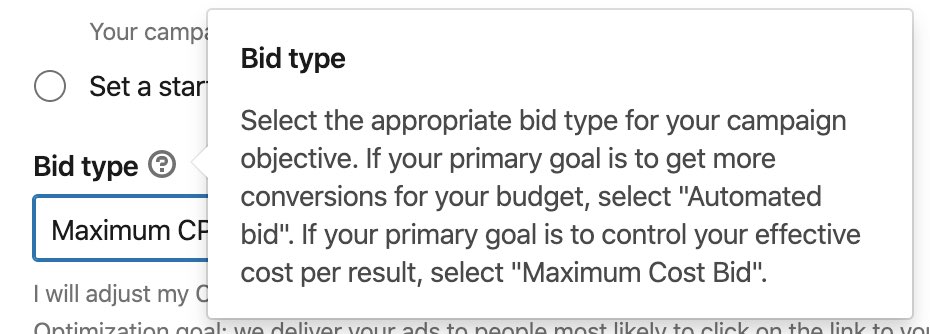
Automated bid automatically makes it rain (and not in a good way!) 💸
Setting an Automated Bid
If you select this option, LinkedIn will automatically bid for you, using machine learning to maximize your set budget and increase your competitiveness. It does so by taking into account your campaign objectives and setting your figures accordingly.
From lead generation and engagement to brand awareness and website conversions, there are many different kinds of objectives that the system takes into account.
You’ll also select this option on your campaign’s “Budget and Schedule” page.
There, under the “Bid Type” section, select “Automated Bid.”
Then, select what kind of bid type you will optimize for. Below are the most common objectives and their associated “Bid Maximized For” optimization:
- Brand awareness: Optimize for impressions
- Website visits: Optimize for link clicks
- Engagement: Optimize for engagement clicks
- Video Views: Optimize for video views
- Lead generation: Optimize for lead generation submissions
- Website conversions: Optimize for conversions and landing page clicks
- Job applicants: Optimize for landing page clicks (only available if you’re using single-image ad format)
Depending on the bid type you want to optimize, the algorithm behind the machine will automatically adjust your bid to increase your odds of winning. One note on this option: It will charge you by impression and is currently only set up to support Sponsored Content.
Protip: In theory, Auto-bid sounds great, but we usually see it spend more than necessary. For that reason we recommend setting a max bid.
Setting a Maximum Cost Bid or Manual Bid
As you did with the automated bid selection, you’ll also head to the “Budget and Schedule” page to set your maximum cost bid.
There, type in the bid amount that you’re willing to pay per pay click, per 1,000 impressions, or per video view.
Not sure what to type?
LinkedIn will provide a recommendation for you, taking your audience targeting and ad placements into account. In addition, you’ll also see a range of prices that demonstrate what your competitors are bidding. Use these numbers to gauge and guide how much you allot.
We usually recommend starting your bid on the low end and incrementally increasing it until you find the sweet spot. If you need traffic faster, then bid higher.
Protip: Unselect ‘Enable conversion optimization’ unless you have a very small audience. This usually seems to spend more than necessary as well.
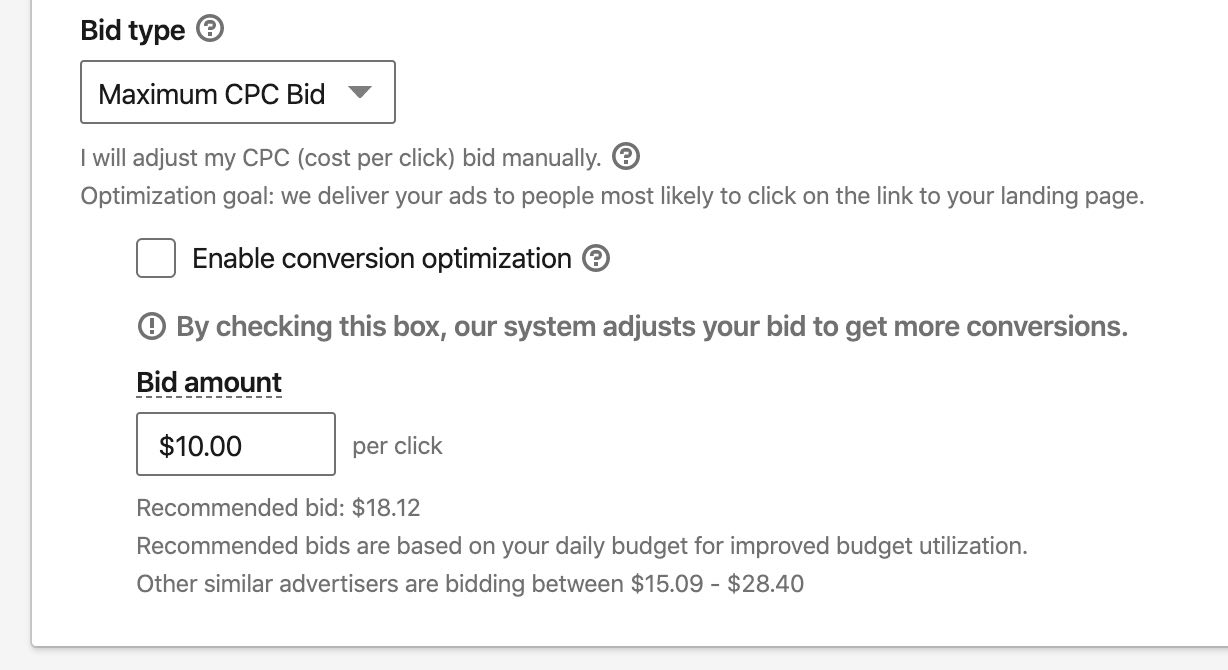
Lock it down! 🔒
Create a Successful LinkedIn Ads Campaign
Are you ready to embrace the power of LinkedIn for marketing and advertising? It’s more than a social network. In fact, it could be the perfect platform to launch your next outreach campaign!
Yet, it’s important to not go into this process blindly. The unique pricing structure and bidding strategy can be challenging to understand, especially at first.
Still spinning your wheels and asking, “How much do LinkedIn ads cost?”
If so, it’s time to partner with our team of lead generation professionals. We know this industry inside and out and we’re ready to help you strengthen your internet presence, boost your brand visibility, improve your customer engagement and grow your bottom line.
Book a call with us today to learn more about what we can do and how we can help. Let’s take this important next step together.
